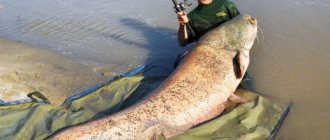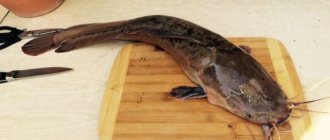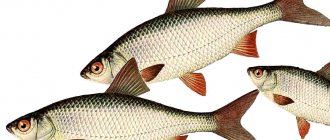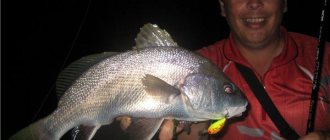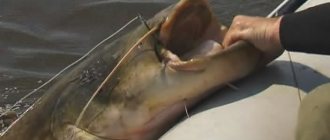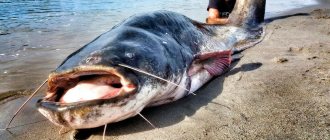Most often, when we mention a fish called catfish, we mean the species European (or common) catfish. However, it must be taken into account that in addition to it, there are more than 100 species of fish that are part of the catfish family and have similar characteristics.
In fact, catfish is a large predatory fish, the main feature of which is the absence of scales. Most often it can be found in warm freshwater bodies of water. An adult can eat not only fish, but also frogs, rodents and birds. If the catfish does not find live prey, it may even eat carrion.
Basic data
The meat of catfish is white and has a very rich taste, due to which this fish is not only caught en masse, but also specially raised in captivity. This can be done due to the fact that catfish is an unpretentious fish that does not need large bodies of water, therefore, this allows for significant space saving during industrial breeding. It is noteworthy that in natural conditions, the spawning time of catfish (late May-June) is the only period when you can catch several individuals at once in one place.
In winter, the catfish hibernates and stops hunting. This allows it to be moved to ponds specially equipped for the winter with other fish, for which in normal times the catfish would pose a very significant threat.
When does spawning begin?
The beginning of catfish spawning directly depends on the climatic conditions in the area chosen by the fish as its main habitat. As soon as the water warms up to the required temperature (above 15 degrees), the catfish begins to spawn.
To spawn, catfish gather in groups, conditionally divided according to age criteria. Due to this, larger fish practically do not hunt their fellows during this period. The gender of catfish at this time is quite easy to determine: males are slightly shorter than females in length and much thinner. In addition, the males cluster around the females and begin to beat the water with their tails, as a result of which quite loud slaps are heard in the water during the period when the catfish begins spawning.
Methods for raising catfish in captivity
Thanks to its unpretentiousness, catfish has become quite widespread as a fish that can easily be raised in captivity, simply by creating suitable living conditions. There are four ways to raise catfish in captivity.
1) Cage method. Catfish spawning takes place in specially equipped cages. After the fry hatch from the eggs, they are separated from the adults.
2) Pond method. The fish are placed in the limited space of the pond and grown almost in natural conditions. In this case, all young animals are caught and raised in hatcheries or spawning nursery areas.
3) Pool method. With its help, catfish can be successfully grown even at home. At the same time, the sizes and types of pools do not play a special role and can vary significantly.
4) Feeding method. The only way in which catfish is grown together with other species of fish. At the same time, it is used not so much for obtaining meat in the future, but as a main assistant for reducing an excessively large population of fish in water bodies. If this procedure is not required, the catfish must be selected in such a way that its dimensions do not exceed the size of other fish and it would not be able to hunt them. However, it must be taken into account that in such conditions, after the spawning of the catfish comes to an end and the fry emerge from the eggs, they are in serious danger of being eaten, if not by the catfish themselves, then by other fish living in the reservoir.
When, where and how does catfish spawn?
As mentioned above, catfish go to spawn in the spring or even in early June when the water temperature in the river or lake reaches a certain level. Therefore, it is clear why in the southern regions of the country our hero goes to spawn at the end of April, and in the northern latitudes the spawning period begins later - at the end of May or at the beginning of June.
At the very beginning of the spawning period, “love games” begin among catfish. Males splash next to females in such a way that, if the reservoir is not very deep, then their splashing can be heard very far from the place of love events. Catfish choose a mate so that it is more or less equal in size to itself. They do this in order to avoid the temptation to eat their future soul mate. To spawn, the couple goes to a deep and, if possible, cluttered place. Parents need clutter so that the small catfish that are born can hide from other predatory fish.
If the river or lake is shallow, then a couple can build a nest in the following places to lay eggs:
- in the reeds;
- during floods on water meadows;
- in grass thickets.
In the chosen place, the female, with the help of her pectoral fins, makes a hole, where, when the time comes, she sweeps the eggs, and the male makes his contribution to the birth of the catfish offspring - he fertilizes the eggs. After the catfish hatch from the eggs, the male and female continue to stay near their young for some time. With blows of their tail, they drive away their enemies from small catfish - other fish predators who are not against feasting on the fry.
At first, small catfish feed on all kinds of vegetation and microorganisms. After a month, the fry can turn into an individual weighing 150-200 grams. At this time, catfish already become real predators - they begin to feed on the fry of other fish, although there is evidence that they can engage in cannibalism - eating smaller fry of their own species.
After spring spawning, the catfish regains its strength within one to two weeks, does not feed on anything, and during this time only poachers can catch it with nets. After a two-week rest, he begins to experience post-spawning gluttony.
During spawning, fishing for catfish and other fish is prohibited by law. Each region of the country has its own deadlines for introducing a spawning ban on fishing, which is quite logical - in our huge country, spring at the climatic level begins at different times and, accordingly, the water in the southern regions warms up earlier, in the northern regions - later.
Features of catfishing
Catfish maintain an active lifestyle throughout the warm season. It is best to start fishing a few hours before sunrise or sunset, when the fish are at their peak activity. Another surge in activity can be noticed if the water is very cloudy and the sun does not illuminate it well. Then the catfish can peck throughout the day.
It is also worth noting the excessive gluttony of this fish after a warm summer shower. At this time, the catfish can swim up to the very shore in the hope of finding snails, worms or even rats that have been washed away by rain streams into the reservoir.
To ensure successful catching of catfish, it is necessary to wait in close proximity to the places where it prefers to stop to rest. It would be useful to pay attention to places where small fish accumulate, which the catfish will begin hunting as soon as it rests. The chances of catching it there increase if there are deep places nearby.
Also, you should not ignore the places where catfish spawn, where, starting in May, you can catch several individuals at once, protecting their eggs from other aquatic predators at this time.
Main habitats
Most often, catfish can be found in close proximity to snags, deep holes, and also under the branches of trees hanging over the water. However, it must be taken into account that he prefers to feed in completely different places.
The lower the water temperature drops, the more often the catfish will begin to shift its activity to the daytime. And with the onset of the first frosts, it swims to deeper places, where it practically stops feeding, preparing for hibernation.
Preparing catfish for reproduction
It is noteworthy that catfish reach sexual maturity approximately in the third year of life. Moreover, the areas for spawning directly depend on the area in which the catfish lives. Its spawning grounds can be found in different places.
- In the rivers. Here the catfish chooses a place in the immediate vicinity of the hole in which it spends the bulk of its time. Even if the river is shallow, it will not swim far and will begin to spawn in the reeds closest to the hole.
- In the lakes. The spawning here is less noticeable than on rivers, since it can be carried out throughout the entire lake. Catfish gather in schools, surround the females and begin to splash their tails. The female, having chosen the most suitable partner, breaks the eggs. If there are more males, one female can have up to 4 partners, of which only the strongest will remain. After the selection is completed, the female and the selected male together drive away the remaining applicants and go deeper into a place suitable for spawning. Then, using their pectoral fins, they dig a hole, the depth of which sometimes reaches 1 m, and throw eggs there. Despite the fact that there is not too much caviar itself, it is quite large and needs space.
- In a fishing pond. Here, spawning begins only after the water warms up to 20 degrees. The area chosen for this purpose must be overgrown with grass, and the water must be either stagnant or low-flowing.
If spawning is carried out in artificially created conditions, females and males must be separated before spawning, otherwise they can significantly injure each other.
Places where catfish spawn
The catfish does not change its habits during spawning; it follows its basic instincts and looks for comfortable conditions for existence: a small current, an abundance of food, the presence of fallen trees, deep holes.
In small bodies of water, spawning occurs:
- on bows flooded during floods;
- in underwater vegetation and reeds.
If the reservoir is deep, the fish prefers:
- whirlpools;
- oxbows;
- flooded ravines.
Read more
What is fly fishing gear and how can a beginner assemble it?
The main selection criterion is the presence of sufficient depth and a soft bottom. If space allows, in artificial conditions, catfish are prepared with original nests consisting of straw and tree rhizomes. If they breed naturally, they spawn on rhizomes or reeds. The spawning process itself occurs quite quickly, only a few days.
If the owner of a fish farm is too closely involved in it, then individuals suitable for reproduction are moved to better conditions. In fact, if he caught a catfish and forcibly moved it to unusual conditions, spawning becomes shorter in duration, as a result of which some of the eggs are lost.
Spawning process
The female, in preparation for spawning, crushes the grass underneath her in such a way that it begins to visually resemble a bird's nest. The spawning period of catfish begins when the water warms up to 20 degrees and is carried out over several spawning runs. In this case, the catfish lays eggs in a fairly dense layer.
On average, one female is capable of reproducing about 20 thousand eggs. After this process is completed, the female and male stay in close proximity for 24 hours, protecting the eggs from enemies. At the end of this period, the female swims away, and the male guards the eggs until the larvae emerge from them.
What you need to know about catfish spawning
When the catfish goes to spawn, violent games begin, which is a sign that the fish is ready to spawn. Only males participate in the games, trying to prove themselves in the best way. Their competition comes down to speed and jumping height. When going fishing in order to catch another fish, sometimes fishermen observe the collection of 100 or more catfish at the same time. The spectacle of the games is truly mesmerizing, as their jumps in the water can often be heard 2 km from the venue.
Read more
What is a drop shot rig for pike perch?
To spawn, the couple goes to a deep and, if possible, cluttered place
Based on the competition, the female chooses her chosen one, then the couple disperses the rejected individuals and leaves for spawning. The whole process is repeated the following year. Egg throwing is carried out in a secluded place; the male first prepares a hole that becomes a nest. Sometimes large males manage to prepare a hole up to 1 m deep. The spawning occurs at night, closer to the dawn. All eggs are quite large, but there are not many of them. The larger the female, the more eggs she can produce.
Fertilized eggs produce mucus, which helps hold the eggs together and stick to surfaces so that they are not carried away by water. The nest is guarded by the parents for about a week, during which time the female and male drive away uninvited guests. When the fry emerge from the eggs, the catfish return to their favorite habitat. Newly hatched catfish, like the fry of other fish, are left to their own devices and try to survive.
Fry
Small catfish emerge from the eggs no later than 10 days after the start of spawning. At the same time, for quite a long period, the main source of nutrition for them is silt and algae. After spawning, the catfish returns to its natural habitats and previously favored holes.
It is noteworthy that a large number of fry die, never reaching the size of an adult, from birds and adult catfish that are constantly hunting. Only a small part of the fry grows to one year of age and turns into adult fish.
fb.ru
The common catfish is the largest predatory fish that can be found in fresh water bodies of Russia, Europe, as well as within the Aral Sea basin.
Distinctive features of the catfish are a long, serpentine body without scales, a flat, large head with a characteristic mustache, and a long, elongated anal fin. Depending on the region, catfish can reach a weight of 4 kilograms (in shallow fresh water bodies) to a length of five meters and more than 400 kilograms of weight. The lifespan of a catfish is more than twenty years. Catfish is a predator; it can lead both a sedentary (in pits and backwaters) and a nomadic lifestyle, depending on the body of water in which it lives. and the size of the food supply. Catfish feed on small and large white fish , amphibians, sometimes even waterfowl, and less often worms (during the feeding season). Catfish activity continues throughout spring, summer and until mid-autumn; in winter, it goes into holes and remains inactive (including not feeding) until early to mid-April.
The catfish is heat-loving; the largest individuals are found in rivers and lakes of the southern regions, in places where the catfish can actively feed. Temperature is also a direct factor influencing the breeding season of catfish, the beginning of which, given this point, varies in different areas by 2-3 months.
Spawning of catfish in the Caucasus and southern regions of Russia begins at the end of April. For the classic middle zone, May-early June becomes a more or less accurate period. From the beginning of the catfish run to spawning, approximately a month passes (from the end of March to the end of April), during which the catfish emerging from their holes actively hunt, which is facilitated by the beginning of the spring spawning of other fish.
At the end of the zhora, catfish gather in places that are considered suitable for breeding - this category includes snags and any points where there is a sufficient amount of silt and debris. Silt is necessary for hatching eggs and feeding the young, and garbage is necessary for protecting the fry from other large predators . At points where it is not possible to find a sufficiently littered bottom, catfish spawn in places full of vegetation, grass and branches (for example, in flooded meadows).
The spawning period of catfish can be determined from the beginning of the “mating games” until the hatching of the young ; it is approximately a month. The beginning of the breeding process is the collection of individuals of approximately equal size in a suitable territory and the choice of partners by females. During the “mating dances,” male catfish gather in groups of 2-6 individuals around the female and begin to splash around her, beat their tails and curl around the female. During such actions, the caviar is also broken.
It is the female who chooses the partner; she, as a rule, determines the strongest or most suitable partner and, together with him, drives away (or even eats) the remaining candidates. After the pair is determined, the male and female go to the bottom , where the female, with the help of powerful pectoral fins, organizes a hole (depending on the size of the catfish, up to a meter deep) where she lays eggs.
Interested in silicone lures? In the article you will find a lot of interesting information about this type of bait.
This article will introduce you to smelt and the behavior of this fish in winter.
When the eggs are laid, the male fertilizes them and the pair remains at the laying point until the eggs hatch into young . Eggs and young animals become the object of hunting by smaller fish, but the male, and sometimes the female, to ensure the safety of the offspring, “patrol” the surrounding area and drive away uninvited strangers with blows of their tails.
When the eggs hatch, the catfish continue to care for them for a few more days, and then go to clean water or to their feeding pits.
Young catfish feed on bottom silt, microorganisms, mollusks and algae, then, having reached the state of fry, they go to the riffles of the river and continue feeding on the fry of other fish species. The spawning period of catfish, the period of which, in general, can be determined at the end of April - mid-July, takes place in large groups from 10 to 100-150 individuals , during which from 4 to 50 pairs are formed.
The process becomes possible at a temperature of at least 20-25 degrees, and can also occur exclusively in clean water, to which the catfish is very sensitive. The eggs mature in seven days, and the spawning process at one point can continue in several passes. A female catfish produces up to 30 thousand eggs per kilogram of live weight, but taking into account the fact that mainly only young individuals reproduce, this amount is considered quite small. A fairly small percentage of the fry that manage to hatch survive until they reach the age of one year - since they are hunted by other fish and the catfish themselves, which contributes to the natural regulation of the predator’s population.
Upon completion of spawning, the catfish goes into the clear water of rivers or to its holes and continues to lead a measured lifestyle as a hunter until mid-late spring , when its fishing again becomes a permitted activity and an excellent challenge for a skilled fisherman.
This article will tell you about the best silicone baits for perch.
And in this article you will get acquainted with relax silicone baits.
In this section https://lovisam.net/vidy-lovli/poplavochnaya you will find information about fishing with a float rod.
lovisam.net
Closely related species of catfish
The common or European catfish belongs to the genus Soma, family Catfish, order Catfish. The order Catfish includes 40 families. The Catfish family includes about 11-12 genera and about 97-100 species. The genus Soma includes 14 species. The closest related species to the European catfish are the Soldatov's catfish and the Amur catfish. In addition to them, on the territory of our country there are Channel catfish and American catfish, which are also included in the order Catfish, but belong to the family of Iktalur catfish.
Som Soldatova
(Silurus soldatovi) is a large fish reaching a length of up to 3 meters and a weight of up to 80 kg. Inhabits the Amur River basin, the Ussuri River and Lake Khanka. In appearance, size and color it is similar to the common catfish. Its back and sides are gray, with brown streaks, and its belly is light. Eats fish. Hunts at night. In the fall it goes to the depths, where it spends the entire winter without feeding. Reaches sexual maturity at 4 years. Spawning of Soldatov's catfish occurs in June-July, in coastal thickets. Soldatov's catfish is considered a rare fish; its numbers are constantly declining, which is why it is listed in the Red Book of the Russian Federation.
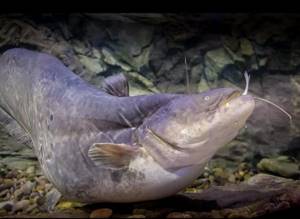
Amur catfish
(Parasilurus asotus) lives in Japan, China and Korea. In 1933, the Amur catfish was released into the rivers of Primorye, where it took root and multiplied. Found in Lake Baikal. The length of the Amur catfish is up to 1 meter, weight 6-8 kg. The body color of the Amur catfish is dark green, the belly is light. Prefers to settle in standing or bodies of water with weak currents. In summer it goes into channels, floods and the coastal zone. In autumn it goes deeper. It feeds on small fish, mollusks, frogs and crayfish. Hunt from ambush in the evening and at night. Reaches sexual maturity by 4 years. Spawning occurs from late May to July. It lays eggs on aquatic plants. The Amur catfish is widely fished; its meat is highly prized for its taste and low bone count.
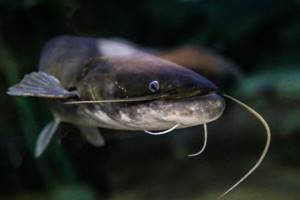
Channel catfish
(Ictalurus punctatus) is a fish of the Ictaluridae family. Lives in the USA, southern Canada, northern Mexico. The body length of channel catfish is from 60 to 130 cm, maximum weight is 4.5-9 kg. The body color is bluish-olive, gray, black, with spots on the sides, the belly is light. It feeds on fish, shellfish, insects, frogs, crayfish, and small mammals.
You may be interested in: Jackall Squad Minnow 80: Special Purpose Wobbler
The most common catfish in North America, about 8 million American anglers fish for channel catfish. Since 1972, channel catfish began to be bred in Russia, in the Krasnodar Territory. From the ponds, the channel catfish entered the rivers of the Don and Kuban systems. Channel catfish are bred in ponds in the Moscow region and the Urals.
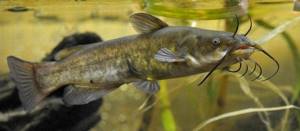
American catfish
(Ictalurus nebulosus) is a fish of the Ictaluridae family. American catfish live in overgrown, slow-moving and stagnant bodies of water with silty bottoms in North America. Introduced to Europe for breeding in ponds, spread throughout the water bodies of Belarus and Ukraine, and can be found in the western regions of Russia. The length of the American catfish reaches 1 meter. Very hardy to living conditions, can live in poor water where other fish species cannot live. Can burrow into the ground. Hunts and feeds at night. Unpretentious in food.
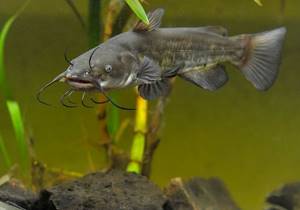
Biting calendar
It is most often possible to catch the first catfish when the water becomes warmer than 10°C. In the spring, the fish bite improves as the temperature rises and turns into a feast before spawning. The fish bite all day. After spawning, catfish are well caught near the pits, but with the arrival of summer heat they switch to night feeding (summer fishing guide). On cloudy, rainy days, fish can feed during the daytime. Before wintering, the catfish feeds heavily, but the bite is inconsistent. Fish often change their tastes and feeding times.
Spawning
Catfish reach sexual maturity at the age of five. Spawning occurs when the water temperature rises above 15°C. Spawning grounds can be in different places, both in shallows and deep bays. But usually these are quiet sections of a river or reservoir. Here the fish gather in groups and arrange special “lekking” events, when the males rub and wriggle against each other, giving the female a choice. Before spawning, the female digs a hole where she lays her eggs. For about 3-7 days, the fish guards the offspring, and when the larvae hatch, the catfish leave the spawning area and return to their holes.
Places where catfish go to spawn
There are no special features in the movements of catfish during spawning - the fish are simply looking for more comfortable conditions, with little or no current. If the reservoir is shallow, then spawning can occur:
- in flooded meadows;
- in the reeds;
- in thickets of grass or algae.
In deep reservoirs, the catfish tries to choose:
- oxbows;
- ravines (flooded with water);
- whirlpools.
A feature of such places should be the depth required for movement and the presence of a bottom with soft soil.
In large reservoirs, special artificial nests made from tree roots or straw are prepared for catfish for spawning. Under natural conditions, giants also prepare for spawning by independently arranging primitive nests, but most often females lay eggs on snags, roots, and reeds.
Some fish farm owners try to move adult fish to more comfortable conditions during spawning. This should not be done - a change in climatic or habitual conditions can forcibly affect the quantity of caviar. The spawning period is also significantly reduced.
Nutrition
The spring awakening of catfish coincides with the beginning of spawning of some fish species. This makes it possible for the sluggish giant to satisfy its hunger with fish that spawn. He does not disdain awakened frogs, worms, leeches and mollusks that have fallen into the water. After spawning, the catfish rushes to the shallows, where it hunts for fish, river lamprey, collects shells, insects and chicks that have fallen into the water. Mice, frogs, and snakes swimming across the river become prey for catfish. Often, a large predator grabs ducks and geese, as well as domestic animals that accidentally fall into the water.
After spawning
After spawning is completed, the male and female scatter in different directions. As already mentioned, immediately after spawning, catfish cannot eat anything for ten to fifteen days, they are so exhausted by the spawn, but then they begin to have a post-spawning glutton. At this time, anglers have no difficulty catching them with any tackle at any time of the day. Zhor lasts after spawning for about twenty days. After the summer heat sets in, although catfish are not very afraid of it, they are nevertheless caught more at night. They come to catfish fishing after 9 pm and stay there until dawn.
It is caught on many types of gear and in a variety of ways.
Here is a short list of gear used for fishing:
- float rod;
- spinning;
- donka;
- kwok.
A huge number of baits, live baits, and artificial lures can serve as bait for this fish.
Look at a short list of ways to catch the freshwater giant:
- Live bait from live fish.
- Frogs are put on a hook.
- Spoons and wobblers are good baits.
- You can catch a small catfish with a bunch of crawling worms.
This is not a complete list of baits that you can use to catch catfish. There are stories from fishermen that they successfully catch catfish using pieces of polyethylene. The plastic film is rolled into an envelope shape and placed on a hook. It is difficult to understand what inhabitant of the deep waters such bait resembles, but the fact is that it provokes a grip, and as a result, the river giant is hooked.
The most successful catching of catfish can be in the post-spawning period, when it begins to eat. However, before you go fishing, you should find out whether the spring fishing ban has ended in your region.
Catfish belongs to the latter species. The penalty for violating the ban can be quite significant.
Search for catfish sites
To catch catfish, an angler needs to look for the deepest parts of a river or reservoir using an echo sounder. The entrances and exits from them become the most catchy places. If not far from the hole there are steep banks, pools, trees and bushes bent over the water, then the catfish may appear here to feed. Before spawning, you should look for fish at a depth of 1-2 m, which is adjacent to the riverbed or hole. Bays and creeks at the beginning of summer are also promising for catching freshwater giants. The catfish rises to the surface only on clear moonlit nights, as well as during a thunderstorm. In the fall, he is one of the first to go to wintering pits.
Groundbait and bait
Feeding catfish is quite difficult. It is easier to lure the fish if you put out the food in the late evening for several days in a row. Worms hidden in pieces of turf are suitable as bait and bait. The catfish can linger for a long time near the bush with crawling worms. Catfish are well attracted by hooves, horns, and feathers of birds burned on a fire. They can also be used as attachments. Some fishermen attract catfish with large shells, which are subsequently used for fishing.
ranoutrom.com
The spawning period of catfish, when it begins to peck
As soon as the water temperature reaches +10ºС, the catfish begins to emerge from the state of winter sleep, and at the beginning or end of April, depending on natural conditions, the catfish may begin to bite. At this time, he does not leave his permanent parking areas. As the water warms, catfish can be seen in the shallows where they can bask in the spring sun. During this period, you can catch it throughout the day, but in the evening, fishing may be futile.
The closer the spawning, the better the catfish’s appetite and the more effective the fishing. Somewhere in the month of May, when the water reaches a temperature of +18ºС , the catfish begins spawning and it continues for 2-3 weeks, after which the fish goes to rest. After a long rest, his appetite awakens, and he begins to feed with renewed vigor. It is during this period that the catfish actively bites, and fishermen get real pleasure from such fishing. The only thing that affects the stability of the bite is the weather, to which the fish react very sensitively. At this time, catfish can be caught both from the shore and from a boat.
Catfish fishing calendar
| January | February | March | April | May | June | July | August | September | October | November | December |
| — | — | — | — | ++ | +++ | +++ | +++ | + | — | — | — |
| January | The catfish is sleepy and its bite is impossible to achieve. |
| February | You can find a wintering hole and try your luck there, but success is unlikely. |
| March | Although the first signs of warming up of the water begin, the catfish stay in the wintering pits at depth. |
| April | The first signs of vital activity of the catfish, it begins to emerge from hibernation |
| May | With the arrival of warm spring days, the predator begins to rise from deep holes in search of food. |
| June | This month is one of the most successful for quok fishing. |
| July | Active biting occurs, the probability of catch increases sharply. Seeing a large specimen is becoming more and more real |
| August | During the flowering of sunflowers, catfish activity peaks; they actively search for food and often come to the surface from bottom holes. |
| September | Catfish activity begins to decline with the arrival of cool weather. |
| October | The predator stops feeding and goes into hibernation pits |
| November | Together with other representatives of large fish, it settles on the bottom and waits out the winter. |
| December | The catfish enters a state of torpor and remains so until warm days arrive and the water bodies warm up. The chances of catching a mustachioed monster are close to 0. |
Up
Fishing methods and gear
In the spring, catfish can be caught using spinning rods and bottom tackle. If you plan to catch catfish using a spinning rod, then the rod must be very durable and match the fishing method.
A spinning rod can be equipped with a reel of various types, ranging from an inertial, Soviet-made one, to a more modern and advanced one - a multiplier. This type of reel is most suitable for catching large specimens weighing up to 50-70 kg. A braided fishing line is wound onto the reel, with a breaking force of up to 30-40 kg. The use of monofilament fishing line is not very justified, since it has less tensile strength for the same thickness, and thicker fishing line is problematic to cast over a long distance.
At this time, the bottom fishing method is quite effective. This method can be used for fishing both from the shore and from a boat. Unlike spinning fishing, a sinker weighing about 30g and a powerful forged hook are attached to the end of such tackle. The weight of the sinker depends on the strength of the current and can be more than 30g. Bottom tackle can be mounted either on a fishing rod or on a regular reel. The reel is convenient because it takes up little space and such gear is convenient to store and transport. Its only inconvenience is the technique of use, especially if fishing is carried out in the dark.
When using bottom gear, a fishing line with a diameter of 0.7 mm or more can be used, and leashes with a diameter of 0.6 mm or more. The main condition for selecting leashes is that its thickness should be less than the thickness of the main fishing line. There can be one or several leashes located at a distance of 20-25cm from each other. As a rule, a bell or an electronic alarm is used as a bite alarm (this is now fashionable). The main thing is that it can be heard at a great distance, especially if fishing is carried out at night.
In the month of May, fishing with a quok is effective, especially when fishing from a boat. It is better to fish from a boat together for several reasons: firstly, you need to control the boat, and secondly, if you catch a large specimen, it will be very difficult to handle it alone.
How to catch catfish in spring
To catch catfish in the spring, it is permissible to use three tackles - a regular bottom tackle with a reel, a modern bottom tackle (feeder) or a spinning rod.
Donka on a reel
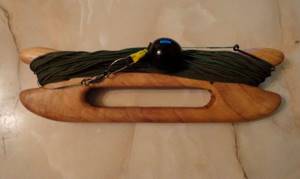
Such gear is rarely used nowadays, especially when fishing from the shore, but it is ideal for catching catfish from a boat. This type of gear is also ideal for catching catfish in the early spring, when the catfish are just starting to bite.
In the initial period, the catfish tries to stay within the wintering pits, so this simple gear is the most suitable fishing gear. Occupying a minimum of usable space, this gear is the most sensitive, since the angler holds the line in his hand, feeling the slightest bite.
This fairly simple tackle consists of a fishing line, to the end of which a sinker is attached, weighing from 40 to 100 grams, depending on the presence and strength of the current. At some distance from the sinker, one or more leashes with hooks are attached. The removal is calculated so that the hooks do not reach both the sinker and each other.
The fishing technique is that the tackle is lowered into the water so that the sinker reaches the bottom, after which the angler waits for bites, holding the line in his hand. To attract the attention of the catfish, it is necessary to animate the bait, from time to time, then raising it, then lowering it, again to the bottom.
Donka on a rod

Catfish can be caught not only from a boat, but also from the shore, regardless of its biting period, although fishing during the pre-spawning period may be the most effective.
During this period, the catfish actively feeds, moving around the reservoir, which makes it easier to find a place to catch it. As a rule, bottom tackle on a fishing rod differs little in its design when compared with a classic bottom tackle. The main difference is the presence of a rod with a reel, since the usual donka includes a reel. Such gear can be easily assembled using a powerful spinning rod, although the best option is to use a special feeder rod.
Such gear is considered universal, since it can be used to catch catfish at any time of the year from the shore.
Spinning catfish fishing
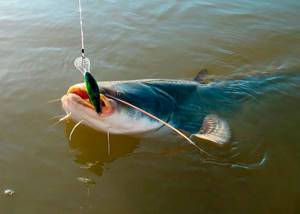
Fans of spinning fishing can go for their trophies when the catfish leave their wintering holes, and this is associated with the second period of spring fishing. Fishing holes using a spinning rod is quite a costly activity, since the holes may contain snags, etc., which leads to frequent snags.
When the catfish begins to leave their winter shelters and actively begins to move around the reservoir in search of prey, a period of active fishing begins for fans of spinning fishing, and during this period you can count on catching real trophies. To catch catfish during this period, spinners use oscillating spoons or fish with a jig.
To catch catfish, you need to have strong and reliable tackle, with a lot of dough, since you have to deal with heavy baits. In addition, catching a real trophy requires a strong, thick fishing line, and the type of fishing line is selected depending on the fishing conditions.
Monofilament line is more suitable for a rod with a hard tip, and braided line (cord) is more suitable for a rod with a soft tip, since it has a much lower specific stretch compared to monofilament line. Such factors must be taken into account in order to dampen the jerks of the river monster.
You should not forget about the characteristics of the reel, since the gain on the tackle can be prohibitive. In this case, preference should be given to power models with a low gear ratio. Any type of reel will do, although it is preferable to purchase a carp inertia-free reel. Inertia-free reels are the easiest to use and allow you to fish large areas of water in a short time.
Such a MONTAGE for catfish! Why, Why is THIS here? Catching catfish IN SPRING.
Baits and lures for catfish in spring
It is possible to use various baits of both artificial and natural (animal) origin. The most popular is the large-sized earthworm (crawlers). They can be collected somewhere in a park area at night, illuminated with a flashlight. As a rule, several worms are attached to the hook. Such bait will mainly catch catfish weighing up to 1 kg.
The catfish will not refuse various insects, which it simply adores, especially such as locusts or mole crickets. But they are very difficult to find. You can try to find a mole cricket under heaps of manure left in the fall, but to do this you need to pick up a shovel and try to rummage. If a mole cricket nest is found, then several specimens are guaranteed for fishing. Well, you’ll have to go to the southern regions to get locusts, which is naturally unacceptable.
As a rule, rivers contain shells or mussels, which can also be used in hunting for catfish, but first you need to open them with a knife, and only then, using the insides, put them on a hook.
In the spring, live bait in the form of a crayfish or a frog can be an excellent and effective bait. Both baits can be caught directly in a body of water, especially the frog, which lives in any body of water as long as there is water.
An oscillating spoon can be used as a spinning bait. Many fishermen prefer modern lures, but traditional oscillating spoons are gradually beginning to be forgotten, but in vain. The oscillator allows you to make wiring at any depth, which is sometimes very effective. A wider but lighter spoon can be used for fishing in shallow water, while a narrow and heavy one can do the job perfectly in depth.
And yet, the jig fishing method, which allows you to literally walk along the bottom of any hole, is very popular among anglers. For this purpose, twisters and vibrotails, ordinary fish or silicone worms, crayfish, frogs, etc. are used.
